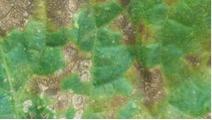Downy Mildew
-
AboutDowny mildews, including Peronospora and Plasmopara spp., are pathogenic water molds (oomycetes) that primarily damage foliage. Hosts include cane berries, roses, various herbaceous ornamentals, and many fruit, grain, and vegetable crops.
 Photo: Courtesy UC Regents
Photo: Courtesy UC Regents -
Category
-
Fungi
-
-
Signs/Symptoms
Downy mildew causes pale green to yellow areas on the upper surface of leaves, and sometimes also discolors buds and stems. Discoloration may turn purplish red to dark brown and necrotic; its shape often depends on leaf veins, which limit the pathogen's spread. Infected leaves may drop prematurely.
Where downy mildew lesions occur on the upper surface of leaves, fluffy masses of brown, gray, or purplish spores form on the underside of leaves. Because spores persist for only a few days under ideal, cool moist conditions, often no spores are visible even though downy mildew is causing damage.
-
Where
Leaves and sometimes buds and stems.
-
When
Downy mildew spores are produced only on living plants and spread mostly with air movement. Spores landing on a host germinate and infect within eight to 12 hours if the plant is wet. Downy mildews are favored by low temperatures (40° to 70°F) and require high relative humidity (≥90%) or wet foliage to produce spores and infect plants.
-
Prevent
To control downy mildew, provide good air circulation and maintain low humidity. Adequately space plants and prune canopies and nearby overhead vegetation. Avoid wetting foliage; use drip or low-volume micro-sprinklers instead of overhead irrigation where feasible.
-
Manage
Promptly remove and dispose of infected foliage to reduce pathogen inoculum.
Control with pesticides (mostly preventive fungicides) is difficult, and modifying environmental conditions can be more effective.
-
More Information

